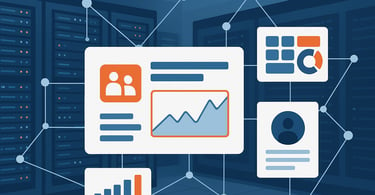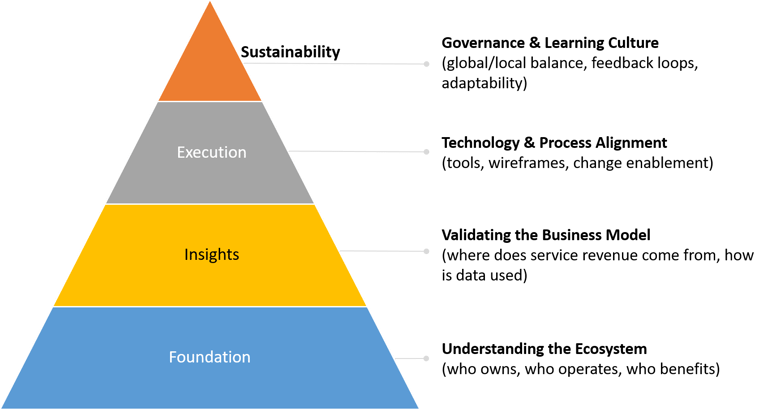Lessons from a Data Center Manufacturer’s Digital Transformation
Mihir Joshi


Digital transformation in manufacturing isn’t just about technology - it’s about understanding who your real users are and how they engage with your products.
This case study, drawn from real experience with a global data center equipment manufacturer, shows how a well-intentioned initiative to increase service revenue and asset visibility evolved into a lesson in alignment, ecosystem awareness, and strategic patience.
This case study contrasts with another example from the HVAC industry, where a manufacturer successfully pivoted its field service strategy during COVID-19 to enable safe returns to offices. Read the HVAC case study here.
Lessons from a Data Center Manufacturer’s Digital Transformation
When Good Intentions Meet Real-World Complexity
Context
The manufacturer sold data center equipment through a wide network of channel partners, distributors, and retailers. Their goal was to strengthen customer engagement and identify new service revenue opportunities by improving visibility into installed assets and ownership.
The organization envisioned a unified digital platform where customers and channel partners could view their installed base, track asset performance, and manage service interactions. The project started with building a customer portal-intended to provide self-service access to product and service information.
Midway, however, the team realized that many data center end users didn’t operate their own facilities; instead, third-party service providers managed the assets. This insight significantly changed how the portal needed to function and who its real users were.
The Business Challenge
At its core, the business challenge was limited visibility of end-user assets and missed opportunities for service growth.
Because assets were typically owned by end customers but managed by third parties, the manufacturer had little direct insight into asset performance, usage, or service needs. This made it difficult to identify upgrade opportunities, offer proactive services, or tailor maintenance plans - key drivers of after-sales revenue.
The portal initiative aimed to address these issues by enabling:
A connected view of assets across the customer and partner ecosystem
Data-driven visibility to uncover service potential
A digital experience that strengthened relationships with both customers and partners
While the vision was sound, its realization revealed how easily digital goals can drift without the right structure, stakeholder alignment, and technology foundation.
The Approach
The program started with enthusiasm but evolved as new realities surfaced. Initially, the focus was on building a customer-only portal, assuming end users would directly engage with it. When it became evident that third parties actually operated most data centers, the project scope had to expand midstream to include partner and channel access.
This required not just additional features but a rethink of data access, privacy, and role management, since partners handled assets for multiple competing OEMs. The organization also had to revisit its technology choice, as the selected platform (Oracle) lacked some essential portal capabilities and would have required significant customization to remain viable.
Despite these hurdles, the program maintained forward momentum by prioritizing design clarity and incremental progress.
Implementation Highlights
Several lessons emerged during implementation:
User insights arrived late. Initially, internal sales teams provided input on what the portal should do, but later, involving actual end customers revealed critical usage nuances, like third-party operations, that changed key requirements.
Technology limitations surfaced early. The chosen tool lacked flexibility and had limited long-term viability for modern portal experiences.
Stakeholder complexity grew. Different regions and business units had unique requirements, which risked fragmenting the common design.
Wireframe-first approach paid off. One positive outcome was the decision to begin with detailed wireframes, which helped reduce development rework and clarified expectations before build.
The Outcome
By the end of the program, the manufacturer successfully launched a feature-rich portal that served both customers and channel partners. It provided valuable visibility into installed assets, enabled data access controls, and laid the groundwork for future service expansion.
However, the journey also underlined the cost of unclear ownership and evolving requirements - the project took longer than planned and required additional post-launch support to maintain momentum.
Still, the outcome demonstrated progress: the organization moved closer to its goal of better visibility and digital engagement. The portal became a foundation to build on, even if the first version wasn’t perfect.
Lessons for Others
Define the audience early. Understand who will use your platform before designing it - customers, partners, or third parties may have very different needs.
Select the right technology for the job. The tool should fit the use case, not the other way around. Think scaleability, performance, capabilities, support before selecting a tool. For a deeper perspective, explore our insights on how to choose the right Field Service Management platform
Engage real users from day one. Internal assumptions rarely capture external realities.
Iterate with clarity. Use wireframes and prototypes to reduce rework and build stakeholder alignment.
Keep scope grounded in strategy. Digital transformation works best when every decision ties back to business outcomes -not platform capability.
This project serves as a reminder that digital transformation is not about getting everything right the first time, but about learning, adapting, and evolving with each phase.
Related Reading


Four Layers of Learning in Digital Transformation
If you’re looking to reimagine your field service operations for customer-centric outcomes, my experience working with global manufacturers can guide your strategy.
Reach out to learn more.
Author Info
Written by Mihir Joshi
After 15 years working with leading manufacturers, I created SmartServiceOps to share practical insights for the field service industry.
